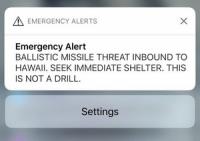-
Predicting the Strength of Earthquakes
Scientists will be able to predict earthquake magnitudes earlier than ever before thanks to new research. “Our research, which is technically rather simple, provides answers relevant not only to earthquake dynamics, but to prediction of earthquake behavior before the earthquake ends,” said one of the researchers.
-
-
Faint Foreshocks Foretell California Earthquakes
New research mining data from a catalog of more than 1.8 million southern California earthquakes found that nearly three-fourths of the time, foreshocks signaled a quake’s readiness to strike from days to weeks before the mainshock hit, a revelation that could advance earthquake forecasting.
-
-
Missile Strike False Alarm Most Stressful for Less Anxious Hawaiians: Study
After learning that a warning of a missile headed to Hawaii was a false alarm, the most anxious local Twitter users calmed down more quickly than less anxious users, according to a study of tweets before, during and after the event. “Can a false alarm of an impending disaster itself be a form of trauma? Our results suggest that the experience may have a lingering impact on some individuals well after the threat is dispelled,” says an expert.
-
-
Machine-learning Competition Improves Earthquake Prediction Capabilities
Current scientific studies related to earthquake forecasting focus on three key points: when the event will occur, where it will occur, and how large it will be. The Kaggle competition, hosted by Los Alamos National Laboratory, provided a challenging dataset that was based on previously published laboratory analysis, to give the competitors a taxing project to explore. Competitors’ success predicting quake timing in the online Kaggle competition could help save lives, infrastructure.
-
-
Q&A: How Ridgecrest Earthquakes Helped Scientists with ShakeAlert
U.S. Geological Survey geophysicist Sarah Minson was in the thick of efforts to develop an earthquake warning system in California when a series of major temblors struck the sparsely populated community of Ridgecrest in the Mojave Desert this summer. The largest, a magnitude 7.1 quake on July 5, was the biggest to hit the state in decades. The Mercury News asked her about her work — and how this month’s big quakes is helping scientists refine California’s fledgling earthquake alert system.
-
-
Americans Focus on Responding to Earthquake Damage, Not Preventing It, Because They’re Unaware of Their Risk
On July 4 and 5, two major earthquakes, followed by several thousand smaller ones, struck Southern California. Their size and the damage they caused captured attention around the country. What tends to get much less notice from the public is what can be done to prevent catastrophic damage from big quakes.
-
-
National emergency alerts potentially vulnerable to spoofing
On 3 October 2018, cell phones across the United States received a text message labeled “Presidential Alert.” It was the first trial run for a new national alert system, developed by several U.S. government agencies as a way to warn as many people across the United States as possible if a disaster was imminent. Now, a new study raises a red flag around these alerts—namely, that such emergency alerts authorized by the President of the United States can, theoretically, be spoofed.
-
-
Telling early moment that indicates a coming megaquake
Just 10 seconds into a quake, GPS data can detect signs of acceleration that point to an event’s magnitude. Likewise, that moment — gleaned from GPS data on the peak rate of acceleration of ground displacement — can indicate a smaller event.
-
-
The why, how, where, and what of earthquake early warning
Earlier this year, Los Angeles became one of the first cities in the country to roll out ShakeAlert – a dedicated earthquake early warning system. Advanced warning of an earthquake has long been a goal for everyone from seismologists to local governments. Especially in cities like Los Angeles, located along the notorious San Andreas fault. But what about cities like Seattle?
-
-
Sensing earthquakes in a new way to help improve early warning systems
Every year earthquakes worldwide claim hundreds or even thousands of lives. Forewarning allows people to head for safety and a matter of seconds could spell the difference between life and death. Researchers demonstrate a new earthquake detection method — their technique exploits subtle telltale gravitational signals traveling ahead of the tremors. Future research could boost early warning systems.
-
-
Crowdsourcing speeds up monitoring of earthquake
Data produced by Internet users can help to speed up the detection of earthquakes. Fast and accurate information is essential in the case of earthquakes: Epicenter location, depth and magnitude are minimum requirements to reliably estimate their possibly catastrophic consequences.
-
-
California hospitals to pay billions for seismic safety upgrades
California hospitals would need to make substantial investments—between $34 billion and $143 billion statewide—to meet 2030 state seismic safety standards, according to a new report.
-
-
A new way to sense earthquakes could improve early warning systems

Every year earthquakes worldwide claim hundreds or even thousands of lives. Forewarning allows people to head for safety and a matter of seconds could spell the difference between life and death. Researchers demonstrate a new earthquake detection method — their technique exploits subtle telltale gravitational signals traveling ahead of the tremors. Future research could boost early warning systems.
-
-
Fast, simple new method for assessing earthquake hazard
Geophysicists have created a new method for determining earthquake hazards by measuring how fast energy is building up on faults in a specific region, and then comparing that to how much is being released through fault creep and earthquakes.
-
-
Lessons learned from Hawaii false nuclear attack alarm

When people in the Hawaiian Islands received a false alarm text message that said “Ballistic missile threat inbound to Hawaii. Seek immediate shelter. This is not a drill” in January 2018, the result was not panic, according to new research. The researchers found that people sought information that could verify their risk and help them decide what to do next.
-
- All
- Regional
- Water
- Biometrics
- Borders/Immig
- Business
- Cybersecurity
- Detection
- Disasters
- Government
- Infrastructure
- International
- Public health
- Public Safety
- Communication interoperabillity
- Emergency services
- Emergency medical services
- Fire
- First response
- IEDs
- Law Enforcement
- Law Enforcement Technology
- Military technology
- Nonlethal weapons
- Nuclear weapons
- Personal protection equipment
- Police
- Notification /alert systems
- Situational awareness
- Weapons systems
- Sci-Tech
- Sector Reports
- Surveillance
- Transportation
Advertising & Marketing: advertise@newswirepubs.com
Editorial: editor@newswirepubs.com
General: info@newswirepubs.com
2010-2011 © News Wire Publications, LLC News Wire Publications, LLC
220 Old Country Road | Suite 200 | Mineola | New York | 11501
Permissions and Policies
Editorial: editor@newswirepubs.com
General: info@newswirepubs.com
2010-2011 © News Wire Publications, LLC News Wire Publications, LLC
220 Old Country Road | Suite 200 | Mineola | New York | 11501
Permissions and Policies
